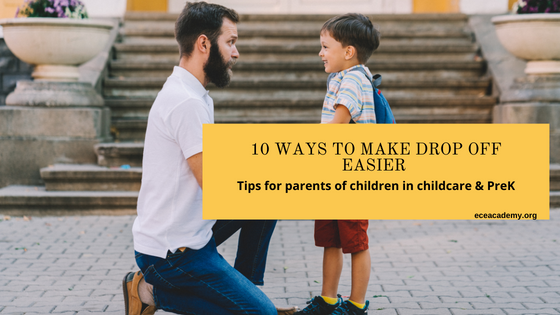10 Ways to Make Daycare Drop Off's Easier
If you have a child on their way to preschool, the scene of a little one clutching onto their parent’s leg with a death grip and pouring tears might sound familiar. It might even resonate on a personal note if you’ve had to pry little fingers off your arm at drop-off.
Going to daycare/preschool can be an exciting time for both a parent and the child/ren, but that doesn’t always guarantee they enjoy the transition from home to school.
Here are 10 ways to help ease the drop-off transition for both you and your child.
Well rested and well-fed makes a happy kid.
Some days can be a blur of rushed teeth brushing and repeating “get your shoes on” 20 million times, however taking the time to make sure they’ve eaten a good breakfast and they get plenty of sleep the night before can make all the difference.
If you’re often finding yourself and your family pinched for time, consider having a few healthy “on-the-go” meals prepped for these types of days. Bowls of fresh fruit, mini pancakes, and breakfast burritos travel well.
Have a casual discussion about school in the morning and on the way there.
If your child feels up to it, ask them if they plan on playing with their favorite playmate, what they’ll build with the legos today, or what their favorite game at the playground is. Helping them get excited about how much fun they have can help build anticipation instead of anxiousness.
Skip the lectures about “no crying” during drop-off. It could just amp up their anxiety and unintentionally create guilt or shame about having a hard time separating from you. Reassure them and remind them that you’ll be returning.
Let them help prepare for school.
Kids love being involved and might be more willing to part ways if they know they’ve had a hand in preparing their lunch or getting dressed. Giving choices and offering to let them help can also remove some power struggles which is an added bonus.
Stay calm.
Children can sense when you’re anxious or nervous about something and that can feed into their own fears. Be confident at drop-offs and show your child you trust them to be in their teacher’s care.
Remember the language you use with yourself too. Instead of thinking “they’re about to start acting up!” when you see the beginning of their tearful meltdown don’t let yourself get riled up. Ground yourself and stay positive.
They could very well cry, but we don’t have to adopt our children’s moods to empathize with them. Children are allowed to be upset, but you’re also still allowed to be calm and excited about their day at preschool.
Make drop-offs simple.
It’s tempting to linger until they settle down but the majority of the time, extended stays can make the separation harder. By doing this the child builds an expectation of you staying or might pick up the message that you’re not comfortable leaving them. Give them a hug and goodbye then drop them off.
If you have to, physically hand them off to their teacher. While the cries might be heart-wrenching, usually a child can be soothed a few moments later.
There might be exceptions when the child seems to do better if you gradually leave and this is something to discuss with the teachers beforehand. You might be able to walk them to the playground instead of using the carpool or help the child put their lunchbox away to give them that extra time with you.
Either way, remember when it’s time to go, it’s time to go. Try not to get roped into the “one more minute” battle. Confidently tell your little one goodbye, you love them, you’ll be back and leave.
Brace yourself for the first few days.
If your child is starting a new school, coming back after an extended break, going through a major life event, or starting childcare for the first time altogether, know that adjusting can take some time.
7. Don’t stress if the second/third day doesn’t go well (even if the first day did).
You might be surprised to see your child stroll into their classroom with no issues the first day, and then delighted to hear they’ve done fine all day only to have them fall apart on day number two. This is normal if the child suddenly realizes that this is going to become a recurrent event.
8. Make a plan for communication.
Sometimes drop-offs are more stressful for the parent than the child. If you’re feeling nervous about sending your little one off without you, don’t be shy about asking your child’s teacher if you can get an update for the first day or two.
Most teachers won’t mind sending a picture of them playing to help you gain some peace of mind.
9. Ask the teacher if you can bring a lovey. Sometimes having a blanket from home can help comfort a child. However, as they become more accustomed to their school, help them learn other soothing methods as well since loveys can sometimes be a distraction in the classroom or cause a quarrel.
If blankets aren’t allowed you could send your kiddo a love note, a picture, or a surprise card in their lunchbox.
10. Don’t sneak out.
This is different than simply leaving quietly if they found something to do. Sneaking out would be something like purposefully pointing your child’s attention towards the classroom fish and then suddenly disappearing. * poof * or pretending like you’re going to get your jacket and then not returning.
This can play into their worst fear about being abandoned and can not only make future drop-offs harder but also leaves them upset throughout the day.
Remember that being upset isn’t a bad thing.
It’s okay for your child to miss you and express this. Continue to be consistent, stay resilient, and keep reassuring them that you love them and will see them after school.





Aggressive behavior like hitting, kicking, and biting are easily cited as one of the most stressful behaviors in the early childhood classroom. Here are some tips for handling aggressive behavior in the PreK/daycare classroom.